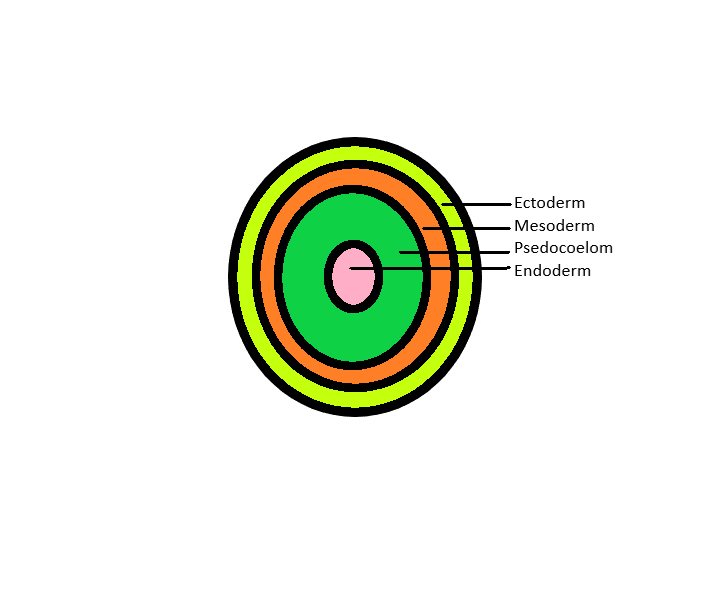
In which phylum are the pseudocoelomates animals placed?
Answer
507k+ views
Hint: The body cavity of the organisms is lined by a layer of cells called mesoderm. This body cavity is called a coelom. This term coelom is coined by the scientist “Haekel”. To be more elaborate, The space between the body wall of organisms and the visceral organs is filled with fluid. This space is called Coelom.
Complete Answer:
The organisms are classified into various types based on the different types of coelom.
They are:
1. Acoelomates
2. Eucoelomates
3. Pseudocoelomates
1. Acoelomates: They do not contain any body cavity hence the organisms having no coelom are called Acoelomates. Example : Platyhelminthes
2. Eucoelomates: They contain a true body cavity filled with fluid lined by mesoderm epithelial cells. Hence the organisms containing true coelom are defined as acoelomates.
Examples: annelida, Mollusca etc.
3. Pseudocoelomates:
They contain the body cavity filled with fluid but they are not lined by the mesodermal epithelial cells. Hence, it is considered a false coelom and the organisms are called pseudocoelomates.
Examples: Aschleminthes - Nematoda, rotifera.
Hence, The phylum under which the pseudocoelomates are placed is Nematoda/Aschelminthes.
Phylum nematoda consists of two classes, namely Aphasmidia, example: Trichinella and Phasmidia, examples Ascaris.

Note:
Pseudocoelom is considered as the false body cavity. Tube within tube organization in organisms started with pseudocoelomates only. It functions as normal coelom only but some muscular movements of organs present internally may be restricted. It also acts as a shock absorber which means it protects organs inside from any external force.
Complete Answer:
The organisms are classified into various types based on the different types of coelom.
They are:
1. Acoelomates
2. Eucoelomates
3. Pseudocoelomates
1. Acoelomates: They do not contain any body cavity hence the organisms having no coelom are called Acoelomates. Example : Platyhelminthes
2. Eucoelomates: They contain a true body cavity filled with fluid lined by mesoderm epithelial cells. Hence the organisms containing true coelom are defined as acoelomates.
Examples: annelida, Mollusca etc.
3. Pseudocoelomates:
They contain the body cavity filled with fluid but they are not lined by the mesodermal epithelial cells. Hence, it is considered a false coelom and the organisms are called pseudocoelomates.
Examples: Aschleminthes - Nematoda, rotifera.
Hence, The phylum under which the pseudocoelomates are placed is Nematoda/Aschelminthes.
Phylum nematoda consists of two classes, namely Aphasmidia, example: Trichinella and Phasmidia, examples Ascaris.

Note:
Pseudocoelom is considered as the false body cavity. Tube within tube organization in organisms started with pseudocoelomates only. It functions as normal coelom only but some muscular movements of organs present internally may be restricted. It also acts as a shock absorber which means it protects organs inside from any external force.
Recently Updated Pages
Why are manures considered better than fertilizers class 11 biology CBSE

Find the coordinates of the midpoint of the line segment class 11 maths CBSE

Distinguish between static friction limiting friction class 11 physics CBSE

The Chairman of the constituent Assembly was A Jawaharlal class 11 social science CBSE

The first National Commission on Labour NCL submitted class 11 social science CBSE

Number of all subshell of n + l 7 is A 4 B 5 C 6 D class 11 chemistry CBSE

Trending doubts
Differentiate between an exothermic and an endothermic class 11 chemistry CBSE

10 examples of friction in our daily life

One Metric ton is equal to kg A 10000 B 1000 C 100 class 11 physics CBSE

Difference Between Prokaryotic Cells and Eukaryotic Cells

State the laws of reflection of light

Explain zero factorial class 11 maths CBSE




